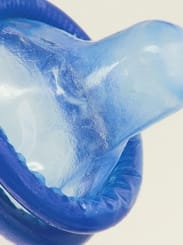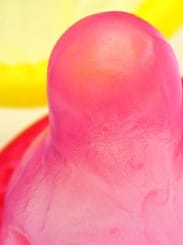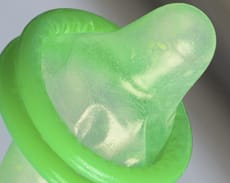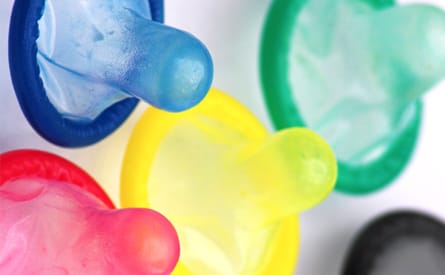

Latex (Latex Vulcani)
Proving date: 2001
Proving completed by: Misha Norland, Peter Fraser & The School of Homeopathy
Common name : Latex Condom
Download: Full proving Latex (Latex Vulcani)
Download: Proving rubrics
About Latex
Insulation, constriction, band sensations, cramping,
and numbness. Violence with shock and paralysis.
Latex vulcani patients typically experience containment and restriction. They feel disconnected and separated from people and from their own feelings. They may have dreams in foreign languages, of not being understood. They often feel as if they were in a bubble, not connecting, separated from danger, and also, in this state they may work without respite. In some, this can lead to ruthlessness or selfishness. Some need to create barriers because their natural ones are weak or absent. The idea of being enclosed or held is important. This gives rise to a feeling of calmness or cosiness. But it can be a more negative feeling of being restricted and can become claustrophobic. Imagery may be sexual or thoughts may be preoccupied with death and birth. But more typically patients feel barren, sterile, invisible, disconnected from their environment and from the events going on around them, unmoved, numb; then the best way to proceed is to go with the flow, whether for good or ill. Violence and external threat may be manifesting but the patient will not connect. This disconnection could be described as a state of shock with patients feeling paralysed by it.
Latex
Natural rubber is found as a colloidol suspension in the latex produced by a number of plants. Natural latex has elastic properties, and can be stretched excessively before breaking. It is a milky fluid found in 10% of all flowering plants and provides protection against insects. It is made up of proteins, alkaloids, starches, sugars, oils, tannis, resins and gum that change to a solid (hard and brittle in the cold) or semi-solid (soft and sticky in heat) state when exposed to air. In many plants, latex is seen as white but can also be yellow and orange. Several species of Compositae, including guayule and Russian dandelion, have been used in rubber production. Several trees in the Sapotaceae family have also been used including gutta percha and mesoamerican trees in the genus Manilkara (from which chicle is collected for use in chewing gum). The purest and commercially most important latex is collected from trees in the Euphorbiaceae family such as Hevea brasiliensis. Key sensations for the family include tied up, bound, entangled, straight jacketed, arrested, ensnared, snarled up, and trapped.
Mythology
Minos: The story of Minos and Pasiphae suggests that sexual disease was a fair punishment and relates to the current stigma placed on people with sexually transmitted infections. Minos chose not to sacrifice a bull sent to him by Poseidon. In anger, Poseidon inflicted Pasiphae with an irresistible passion for the bull and after wooing, she conceived the monstrous Minotaur. Having 8 children, Mino and Pasiphae were seen as prolific. Mino had 5 children of his own and a mistress that enraged his envious wife. She put a curse on Minos so that serpents devoured all women with whom he made love. The goddess Procris wanted Minos as a lover and provided him with a cure. Unaware of the actual cure, the myth suggests that she slipped the bladder of a goat into the vagina of a woman and into this bladder Minos cast off his serpent. From this, the uses of animal bladders were used to protect women against possible pregnancy and infection.
History
Collection of latex: A cut is made in the bark of the tree that leads into a bowl where the latex is collected. As the latex dries, the cut heals and this is extended downwards each day. When it reaches the ground the tree is left to heal and later, a new cut is made. The history is one of unimaginable cruelty; cruelty to the tree that is slowly bled to death and to those who collected the rubber. Natives were forced to become slaves and given impossible targets for the amount of rubber they had to collect. Punishment, mutilation and murder was meted out to those who did not meet the targets. Tales of the brutality were rejected in Europe and America despite campaigning by Mark Twain, Joseph Conrad and others, until the first effective photojournalists such as the missionary Alice Harris, brought home the horror of what was happening.
The first condoms: The earliest documented strain of syphilis was recorded after an outbreak in Europe in the 1490s. The use of condoms for the prevention of syphilis and unwanted pregnancy, form part of a cultural history based on shame and fear among sexual affiliations and social ethics. In Egypt, Greece and Rome, protection against pregnancy was regarded as the woman’s responsibility. In 15th century Asia, the use of glans condoms is recorded. In China, glans condoms were made from oiled silk paper or lamb intestines; in Japan, tortoise shell or animal horn was used. In Renaissance times, condoms were made from intestines and bladder. Condoms for contraception were known only to the upper classes. The invention and naming of the condom is attributed to Dr Condom, at the court of Kings Charles II in the 1600s, who was alarmed by the number of Charles' offspring. There is no proven name for the word condom however the Latin name 'condus', meaning receptacle, has been used and speculation continued with the use of an Italian word ‘guantone’ meaning glove.
16th, 17th and 18th centuries: Gabriele Falloppio's treatise about syphilis includes the earliest description of condom use, describing a linen sheath that was soaked in a chemical solution being allowed to dry before it could be used. The use of coverings for birth control, rather than disease, is described in literature throughout Europe. During the late 16th century, the Dutch introduced fine leather condoms to Japan. In 1605, a theological publication condemned the use of condoms as immoral. In 1770, Joseph Priestley discovered that pencil marks could be erased by rubbing with a piece of rubber and so gave it its name. In 1791, Samuel Peal patented a process of waterproofing cloth with rubber.
19th century: Charles Macintosh began to produce rainproof garments in 1823. During 1834, Ludersdorf and Hayward found that by adding sulphur to rubber its stickiness was reduced. In 1839, Goodyear discovered that heating rubber and sulphur together (vulcanization) gave the rubber increased strength and elasticity and reduced its sensitivity to temperature. In 1855 Goodyear produced the first rubber condom, manufactured by wrapping strips of raw rubber around shaped moulds that were then dipped in a chemical solution to cure the rubber.
20th century: In 1912 a polish inventor produced a new manufacturing technique by dipping glass moulds into a rubber solution, adding additional gasoline or benzene to turn the rubber to a liquid. By 1920, latex rubber suspended in water was invented and required less labour to produce.
Culture: In the 18th century, condom use was opposed in some religious, legal and medical circles. When the 19th century arrived, there were mixed views about condoms – some preferred other methods of birth control and feminists disapproved of male-controlled methods. The unreliability and expense of condoms was debated, however, it was believed condoms were a good option for some as this was the only contraceptive that also protected from disease. Contraceptives were offered to the poorer classes and many countries passed laws forbidding their promotion. The German military was the first to promote the use of condoms amongst their soldiers. During WWI, the USA and Britain were the only countries that had soldiers in Europe who did not provide condoms or promote their use. During 1920, the Church of England condemned all ‘unnatural means of conception avoidance’. In 1930, legal restrictions on condoms became relaxed and condom sales increased. Today, attitudes are radically different, with AIDS deterrence recommending condoms. Roman Catholic culture opposes sexual acts outside marriage and protection against STIs is a topic of debate. In Africa, some Muslim and Catholic religious officials disallow the use of condoms. Traditional beliefs that Islamic teachings should be observed, which eschew extramarital affairs, are reflected by Sheikh Mohamud Ali, who writes, 'A huge amount of money is spent on buying condoms, buying immorality'.
Medical uses: The effectiveness of a condom depends on knowledge of the user. They are highly recommended for the prevention of STIs, and have shown a significant reduction in infections that cause AIDS, genital herpes, cervical cancer, genital warts, syphilis, chlamydia, and gonorrhoea. However, the condom can fail, slipping off after sexual intercourse and breaking due to incorrect application or physical damage. If the latex is past it expiration date it can degrade, causing it to break or slip. Latex is a particular problem for some health workers who have become sensitised to it, developing skin irritation and allergic reactions. Incidences of infant eczema and asthma may be attributed to neonatal sensitisation to the latex-gloved hands that welcome almost all western babies into the World.
The proving
The remedy was prepared by Peter Fraser. A grain of latex from a non-spermicidal condom, cleaned of any traces of lubricant, was cut into small pieces and triturated in a porcelain pestle and mortar with milk sugar. Peter wrote, 'I was hot and perspiring. Trembling. The substance was hard and stubborn and my reaction was of a similar quality. Felt a tendency to become obsessive/compulsive as I worked at the trituration. The smell was nauseating, this went right on into the 3c trituration.
I was belching and felt nauseous, almost, but not quite to the point, of vomiting. I had a sick headache. Felt that the skin on my head was tightening. Heat in the forehead. Felt rushed and hurried, carried away with the process. Became aggressive and violent. Felt so sick that I had to take 2 long breaks in the process. Was clumsy and dropped and smashed things.'
Rubber is associated with work – just think of the billions of tyres taking us to and from work! In Latex vulcani, Sulphur is the binding agent, turning soft sap into the tough, elastic material we find so useful, and we see Sulphur themes in the proving. As well as itching, skin symptoms and problems at orifices, muco-cutaneous borders, stomach, intestines, etc., we might expect relationship issues to arise. The 'glue', which Sulphur is to hydrocarbon molecules, as it is in rubber, might express itself in the psyche of the patients as relationship breakdowns (lack of glue) as well as insulation, lack of connection, and indifference. Latex is used in the manufacture of baby teats and dummies, so it could have a place in the treatment of bottle-fed babies, further amplifying the themes of disconnection, disgust, and neglect. Since physical contact is mediated by skin, it follows that these symptoms should have a particular meaning within the context of patients who had been bottle-fed babies.Other aspects of Sulphur and rubber, are fire and stench. How rubber burns! There are symptoms of heat, sweating, foulness and self-loathing. Latex has a protective function – it provides a covering for a plant wound, as fibrinogen does for animals in the formation of a scab. Given the attack upon the trees, it is small wonder that there are imaginations or dreams of attack, and images of knives and cutting.
Some provers felt they lacked boundaries, felt vulnerable; some experienced clairvoyance, while others developed symptoms of claustrophobia, feeling restricted, constricted with band sensations. There were also themes of insulation and being cosy, calm and still. Provers described themes of disconnection, as if cocooned in a bubble. There were incomprehensible dreams in foreign tongues. They became suspicious of violence - the cocoon providing unreal separation from danger, lack of feeling, lack of sensation (shock and paralysis). The barrier to disease afforded by wearing a condom also expressed as a barrier to feeling and touch, as sterility and inhibition, however, there was recklessness, feeling over-confident, indeed brave and ruthless, strong and selfish, 'saying what I feel like saying without fear of repercussions' and feeling out of control. 'I knew I had done something really dreadful and that I would be discovered.' Shameful guilt.
Rubber is a favorite material for fetish wear. It covers and conceals, yet is so stretchy that it becomes a second skin, embracing both the sexuality of nakedness and the titillation of concealment. Rubber reveals properties of binding, constricting and holding, yet it gives because of its elasticity.
Download: Full proving Latex (Latex Vulcani)
Download: Proving rubrics

Cocooned - Restricted - Unreal separation - Ruthless - Sterility - Out of control - Violence - Paralysis - Reckless - Lacking boundaries - Suspicious - Enhanced senses - Shameful guilt
Proving Themes
Background
Birth control type : Barrier
First use : Ancient
Rubber: 1855
Latex: 1920
Polyurethane: 1994
Polyisoprene: 2008
Kingdom Taxonomy
Latex is collected by making a cut in the bark of the tree. The diagonal cut leads into a bowl where the latex is collected. As the latex dries the cut heals up and it has to be extended downwards on a daily basis. When it reaches the ground the tree is left to heal and some time later a new cut is made.

.jpg)
